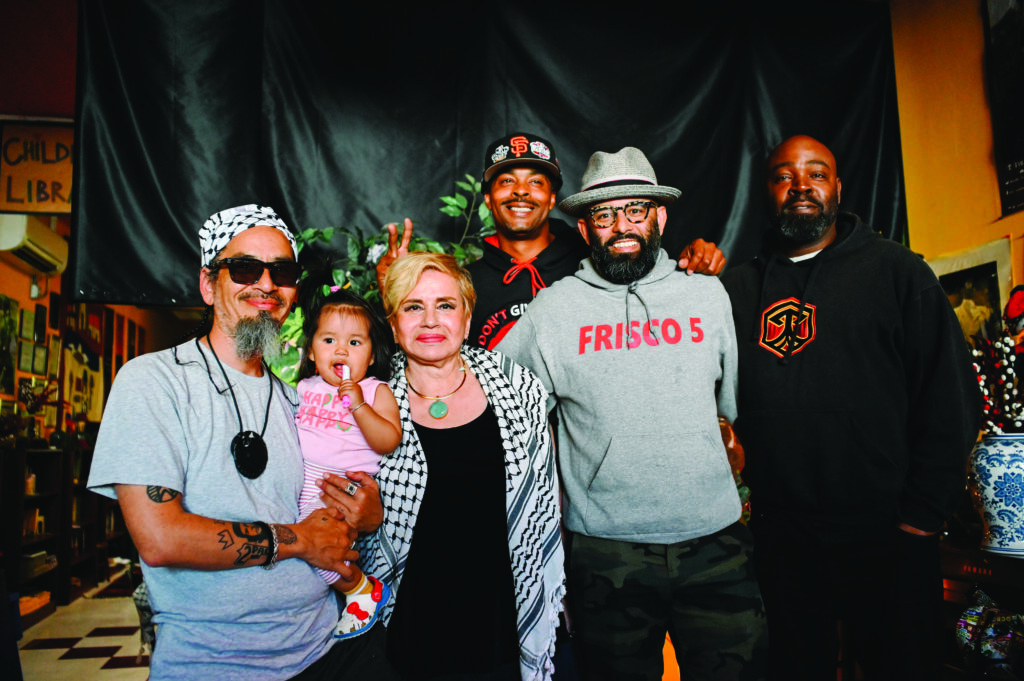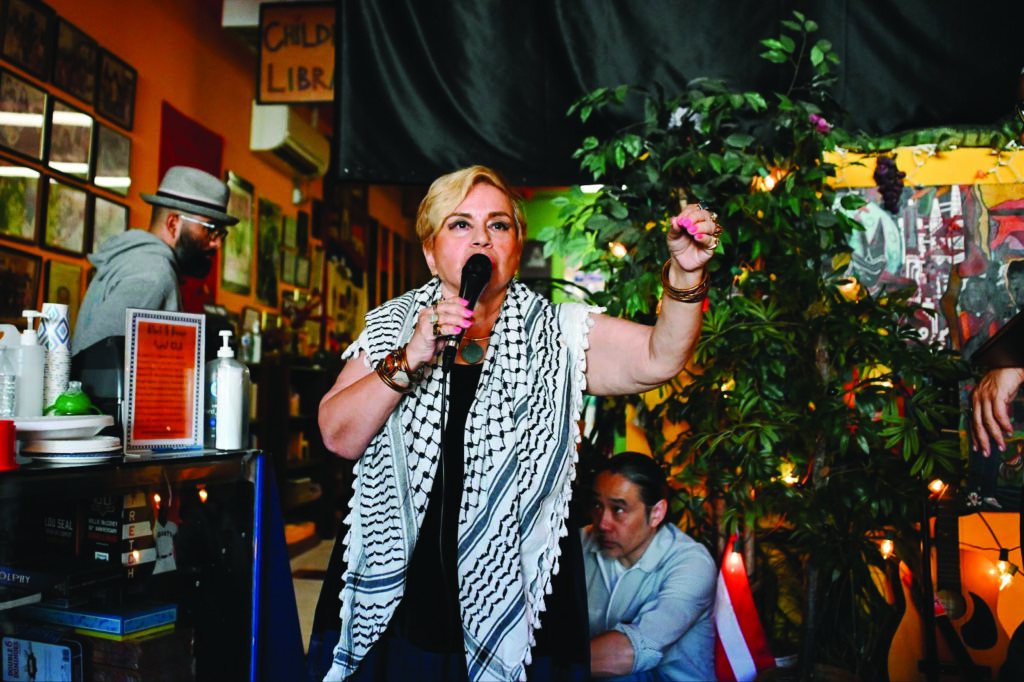
Frisco 5 hunger strikers. Black n’ Brown Social Club April 21, 2024.
Last April, community advocates against police injustice and onlookers gathered at the Black n’ Brown Social Club to commemorate the eighth anniversary of the Frisco Five hunger strike, a protest that led to the resignation of San Francisco’s Chief of Police and inspired a movement fighting against police brutality in Frisco. For 17 days, the five strikers—Maria “Mama Christina” Guiterrez , her son Ilyich “Equipto” Sato , Ike Pinkston , Edwin Lindo, and Sellassie Blackwell—went on a hunger strike to draw attention to repeated instances of racial bias and excessive force by the San Francisco Police Department. At the anniversary gathering, attendees had the opportunity to learn about the 2016 hunger strike from the Frisco Five themselves.
The Frisco Five members began their hunger strike shortly after the San Francisco Police Department murdered Luis Gongora, a homeless man of Mayan descent living in an encampment underneath the US-101 in the Mission District. On April 7, 2016, two police officers arrived at Shotwell and 18th Street after a 911 call about a man brandishing a kitchen knife. According to Mission Local, both a witness on the scene and Officer Mallone’s own police report stated that Luis Gongora was found sitting down on the pavement and posed no threat to the officers, but officer Mallone then shot four bean bag rounds at Gongora, claiming he wasn’t responding to commands. SFPD alleged Gongora got up from the pavement and charged at them with a knife after they shot the beanbag rounds. Officer Steger then fired 7 bullets from his gun at Gongora, killing him.
No charges against the officers were ever made.
Around the same time, eight police officers were fired for racist and homophobi text messages that had been released to the public. Six of these same officers were later accused of stealing from drug dealers. But when the San Francisco Police Commission recommended policy changes, the San Francisco Police Officers Association (POA) refused to adopt any of them.
After so many scenarios of SFPD racial bias and excessive use-of-force, including the murders of Alex Nieto (3/21/14), Amilcar Perez Lopez (2/26/15), Mario Woods (12/2/15), and Luis Gongora (4/7/16), activists would need to do something drastically different to fight back. One of the activists calling for change was Mama Christina. She would become a central figure in the resistance, leading activists to a much more effective, but risky protest. They would fight police brutality by putting their own lives on the line.
Mama Christina’s Leadership

Mama Christina speaking on the Frisco 5 hunger strike. Black n’ Brown Social Club
April 21, 2024
Mama Christina was no stranger to protesting against injustice. She got her start in organizing from her father while growing up in Colombia. She recounted to El Tecolote magazine how her father organized the first trade union of telephone workers in the 1960s. She remembered hearing her father tell her mother, “We have to fight to change the conditions of our country.” Christina’s father’s words are a guiding source.
Christina has lived in San Francisco for more than 40 years. She is an active member of the Justice 4 Mario Woods Coalition: Mario Woods was murdered by SFPD in December 2016 with 27 gunshot wounds that ultimately was broadcasted online by cellphone camera footage. She also founded and leads Mothers on the March, a collective of women whose children were killed during interactions with the police. Every Friday, they stand outside the Hall of Justice and passionately demand: “Jail Killer Cops!” Her son, Equipto stated, “Sometimes a lot of the survivors don’t have a platform or the confidence to address their personal issues. I think my mother helps out with that.”
Before the hunger strike started, Mama. Christina told her son that she “was tired of marching” about SFPD murders and wanted people to pay attention to the police. When she called for a hunger strike, Equipto, along with Blackwell, Lindo and Pinkston collectively joined. The five strikers were not only going to get people to pay attention to SFPD, they were going to get the Chief of Police out of power as well. As Edwin Lindo stated, “you have to take the head off of the snake…and the SFPD head was Greg Shur.”
The Strike
On Thursday, April 21, 2016, the Frisco Five began their hunger strike by setting up tents outside of SF’s Mission District police station. Armed with only coconut and vitamin water, they vowed to stay put until SFPD chief Greg Suhr was fired or resigned. As days passed, the community came out to show their support, including Aztec danza dancers, lowriders, and even medical doctors. Dr. Rupa Marya and other student-physicians even made a makeshift medical clinic, so they could monitor the health of the strikers, checking the Frisco Five’s blood pressure and monitoring their weight loss.
“As the days went by, the group rallied around Mama Cristina,” Edwin Lindo said. “She was the force who held them together.” It wasn’t until the thirteenth day that the Mayor, Ed Lee, reached out to the Frisco Five members to meet with them privately at the Mission Police station. Rather than agree to the Mayor’s attempt to circumvent the momentum from the hunger strikers publicity, the Frisco Five organized a march with hundreds of supporters throughout the Mission District to City Hall, demanding Lee meet them on their terms. The members of the Frisco Five led the charge in wheelchairs, each being monitored by a medical doctor. Not surprisingly, Mayor Lee never showed up.
Later that afternoon, all five organizers were hospitalized. But the strike did not end here. The Frisco Five’s political action galvanized supporters to continue their fight.
The Turning Point of the Hunger Strike
On the sixteenth day of the hunger strike, supporters of the Frisco Five marched to City Hall. Ike Peterson recalled how hopeless he felt with his fellow comrades until he witnessed well over 800 people marching. The crowd turned into what is known as the Frisco 500 collective.
As protestors barged through the front doors of City Hall, they were met by dozens of sheriff deputies in full riot gear armed with batons. The Frisco 500 successfully pushed through the deputies and then began banging on the Mayor’s door, calling for the removal of the police chief.
A massive protest erupted inside City Hall with several organizers, as well as journalists, getting “shoved and manhandled by sheriff ’s deputies.” They arrested 33 people, including one juvenile. Their occupation of City Hall lasted over seven hours.
The following day, May 7, 2016, the Frisco Five called off their hunger strike due to severe weight loss. Two weeks after calling off the hunger strike, SFPD killed an unarmed Black woman, Jessica Williams. It was at this moment that the Mayor Ed Lee was forced to address the lack of police accountability, at which point he told Chief Greg Suhr to resign. If it weren’t for the Frisco Five’s sacrifice for justice, Suhr’s ousting would never have happened.
The following year, Greg Shur was hired as Golden State Warriors’ head of Security; however, due to community outcry on Twitter, he was immediately fired.
At the Black n’ Brown Social Club last April, the Frisco Five reflected on the sacrifices they made for their cause. One member said, “Going into a hunger strike is something you don’t plan, until you feel no other options will work.” As we look back on what happened eight years ago, and at the growth of Cop Cities in our communities, we all will need to reflect and decide what we are willing to sacrifice for the cause.
A version of this story was also published in Frisco Voices.
Joshua “Balto” Baltodano is the founder of Frisco Voices, an online nonprofit news outlet. He is also an active member of Frisco Cop Watch and resides in the Mission District.
